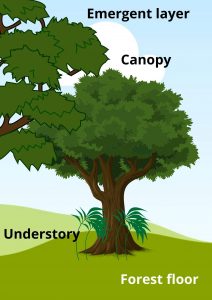What are Forests?
Although no definition of Forests has been laid as yet, but a forest is usually defined by the presence of trees, under many definitions an area completely lacking trees may still be considered a forest if it grew trees in the past, will grow trees in the future, or was legally designated as a forest regardless of vegetation type.
Forests can be classified according to a wide number of characteristics, with distinct forest types occurring within each broad category.
Broadly, forests can be classified under the following categories:
- Forest Type # 1. Equatorial Moist Evergreen or Rainforest
- Forest Type # 2. Tropical Deciduous Forest
- Forest Type # 3. Mediterranean Forests
- Forest Type # 4. Temperate Broad-leaved Deciduous and Mixed Forest
- Forest Type # 5. Warm Temperate Broad-leaved Deciduous Forest
- Forest Type # 6. Coniferous Forest
Forest Layers
Forest floor contains decomposing leaves, animal droppings, and dead trees. Decay on the forest floor forms new soil and provides nutrients to the plants. The forest floor supports ferns, grasses, mushroom and tree seedlings.
Understory is made up of bushes, shrubs, and young trees that are adapted to living in the shades of the canopy.

Canopy is formed by the mass of intertwined branches, twigs and leaves of the mature trees. The crowns of the dominant trees receive most of the sunlight. This is the most productive part of the trees where maximum food is produced. The canopy forms a shady, protective “umbrella” over the rest of the forest.
Emergent layer exists in the tropical rain forest and is composed of a few scattered trees that tower over the canopy.